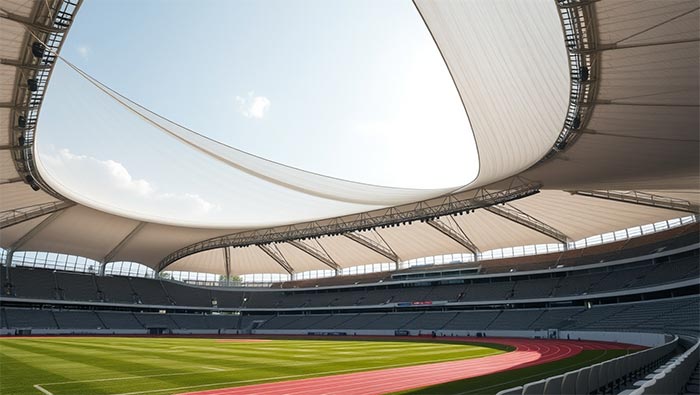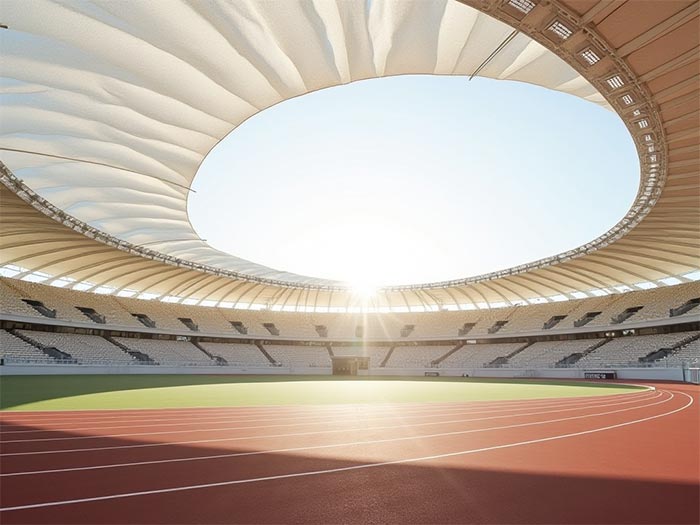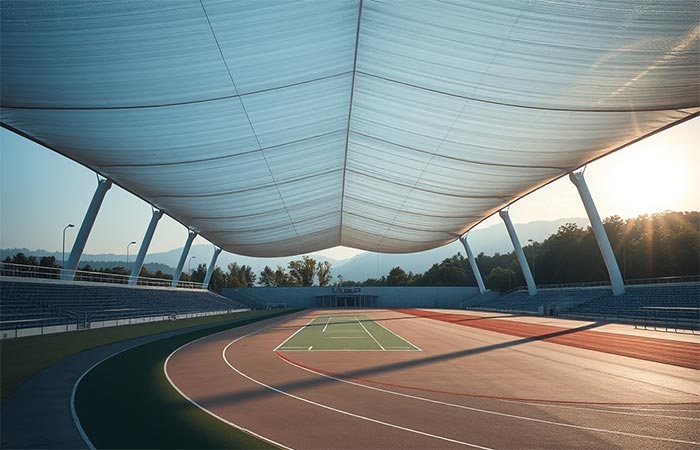Tension membrane structure empowers athletics field
In the field of modern sports architecture, tension membrane structure is becoming an innovative force in track and field design with its unique mechanical properties and architectural aesthetics. As one of the core application scenarios of tensile membrane structure, track and field achieves a perfect balance of span, light transmittance, durability and ecology through this technology.

Tension membrane structure: the “lightweight revolution” of track and field
The traditional track and field roof mostly uses steel structure or concrete frame, which not only has a large self-weight and a long construction period, but also may affect the performance of athletes due to poor shading effect. The tensionmembrane structure achieves the effect of “soft overcoming hardness” through the synergy of high-strength membrane material, steel cable and supporting structure:
- Large span coverage: The tensile characteristics of the membrane material can easily span a space of more than 100 meters, without the need for intermediate columns, to ensure a wide field of view of the track and field.
- Light transmission and energy saving: The light transmittance of the membrane material can reach 10%-25%, and the natural light is evenly distributed, reducing the energy consumption of daytime lighting.
- Wind and earthquake resistance: The flexible structure can effectively disperse external forces such as typhoons and earthquakes, and the safety is significantly improved.
The track and field stadium with tension membrane structure as the core not only meets the stringent requirements of international events for venues, but also creates a transparent and modern viewing experience for the audience.

Technical extension of tension membrane structure in track and field stadium: the integration of tensile structure and tensile building
The innovation of tension membrane structure is not limited to the ceiling design, but also reshapes the overall form of the track and field stadium through the combination with tensile structure and tensile architecture concepts:
- Dynamic curved surface design: The flexible characteristics of membrane materials allow architects to create streamlined and bionic shapes, such as “wings” and “dome”, giving the track and field stadium a strong visual tension.
- Multifunctional composite space: The membrane structure can be integrated with the stands, lighting systems, and ventilation equipment. For example, photovoltaic membrane materials can be integrated into the ceiling to achieve clean energy supply.
- Modular and fast construction: Prefabricated membrane units can be installed in a short time, especially suitable for temporary event venues or post-disaster reconstruction projects.
In an international track and field project in the Philippines, the combination of the tension membrane structure roof and the tensile sunshade stand not only reduced the material cost by 40%, but also shortened the construction period, becoming a model of tensile structure building in the field of sports.

How does the tension membrane structure improve the performance of the track and field?
1. Singapore National Stadium: Its double-layer tensile membrane roof can be completely closed, and the temperature and humidity in the stadium can be adjusted through the intelligent temperature control system to ensure all-weather event operation.
2. Tokyo Olympic Track and Field Stadium: ETFE membrane material is combined with steel cables to achieve a coverage of 25,000 square meters of space under a deadweight of 15,000 tons, and the seismic performance reaches level 9.
3. A rural track and field stadium in Africa: The low-cost PVC membrane structure roof is matched with local bamboo supports, which can reduce the cost by 60% while ensuring the sunshade and rain shelter function.These cases prove that the tensile membrane structure is not only suitable for large-scale event venues, but also can be adapted to the needs of track and field stadiums with different budgets and climatic conditions through material and process optimization.
Key considerations for choosing a tension membrane structure track and field
- Durability of membrane materials: Choose PVDF, ETFE and other UV-resistant and self-cleaning membrane materials according to the climate, with a lifespan of 15-30 years.
- Structural safety: Wind tunnel testing and seismic calculations are required to ensure stability in extreme weather.
- Maintenance cost: Regular cleaning and inspection can extend the life of the membrane material, and the intelligent monitoring system can provide real-time warning of structural abnormalities.

Conclusion
From competitive stadiums to community sports spaces, tension membrane structures are becoming a new choice for track and field construction with their unique technical charm and ecological value. Through the in-depth application of tensile structures and tensile building concepts, the future track and field will not only be a carrier of sports, but also a perfect fusion of technology, aesthetics and sustainability.